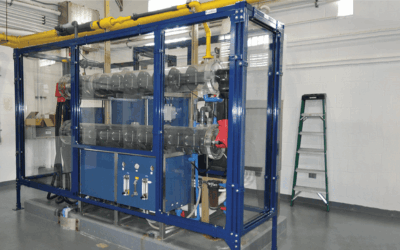Kevlar shielding blankets are essential across diverse industries, providing a reliable defense against dangerous projectiles and explosive threats.
Renowned for their remarkable strength and flexibility, these containment blankets have become a favored solution in numerous applications, including pneumatic or hydrostatic pressure testing, blast mitigation, machine guards, and any scenario involving potential threats that could cause property damage or pose a risk to individuals.
However, choosing the right Kevlar curtain is a decision that hinges on considering several important factors. In this blog post, we’ll walk you through the top five essential considerations to keep in mind when selecting a Kevlar blanket.
- Purpose and level of protection needed
When considering a Kevlar blanket, it’s important to recognize the variety of styles and protection levels available. Factors like cost, weight, protection, and portability should guide your choice to ensure the perfect fit for your facilities and procedures needs.
At TotalShield, we will analyze a customer’s operation and examine the possible threats for which a Kevlar blanket would be needed. We conduct a thorough analysis of your specific operation, assessing potential threats that may require a Kevlar blanket. We meticulously calculate projectile velocities and associated energy, then evaluate the energy-to-surface area ratio based on our extensive test data.
Our range of Kevlar blankets extends from single-layer options to robust 15-layer solutions. The total number of layers depends on your unique threat scenario. We always incorporate an additional safety margin to safeguard your personnel and equipment.
This analysis is paramount in balancing safety and cost-effectiveness, ensuring you receive the ideal solution for your requirements.

- Material and construction
The performance and durability of a Kevlar tarp depend significantly on the quality of its material and construction.
Opt for blankets with inner-layers made with genuine Kevlar fibers, as inferior materials can compromise overall protection. Look for reputable manufacturers who enforce stringent quality control standards, ensuring consistency and reliability.
Additionally, there are different weaves of Kevlar fabric, and some weaves are more effective than others when it comes to ballistic or explosive resistance. The orientation of the weave and how it is overlapped when using multiple layers also affects the overall durability of the Kevlar curtain.
The choice of outer cover for the blanket is also pivotal. While Kevlar is exceptionally strong, it is vulnerable to moisture, sunlight, environmental conditions, abrasion, high temperatures, and wear and tear. The outer cover serves as a protective shield, safeguarding against these factors.
For applications demanding heat resistance up to 200 °F, TotalShield offers a 14 oz. Polyester vinyl outer-layers. Alternatively, for those with higher heat resistance needs, our blankets come equipped with an outer-layers made of Silicone-coated fiberglass.
You also need to consider the blanket’s construction, including the number of layers, stitching, and overall design. A well-constructed blanket significantly enhances its effectiveness and longevity.

- Mounting/Securing method
Once you’ve determined your required level of protection, the next step is to strategize the positioning of the shielding blanket to ensure it offers optimal safety and convenience within your facility’s workflow. Questions to consider include:
- Will the blanket remain fixed in a stationary position?
- Is it a temporary or permanent solution?
- Can it be wrapped around and securely fastened to the equipment it’s safeguarding?
- Does it need to be moved to facilitate access for people or equipment?
- Is additional structural support necessary?
At TotalShield, our commitment is to deliver tailored solutions that precisely match your unique requirements. We collaborate closely with you to design a solution that fits seamlessly. Various attachment methods, such as grommets, rope tunnels, hook and loop fasteners, webbing, or customized mounting hardware, ensure secure attachment.
Always remember: even the most robust blanket can only fulfill its protective role when securely affixed!

- Integration into your operation
Are you implementing this for an existing operation where added safety is the goal, or is it part of a new project? In either scenario, it’s imperative to guarantee that the shielding blanket seamlessly integrates with your processes.
If the visibility of your operation is crucial, consider if you require the addition of cameras to monitor the process, or maybe we can integrate a clear polycarbonate window.
Let’s say you will construct a roof above a test bay. In that case, you would need to consider supplementary lighting due to potential obstruction by the blanket.
If the Kevlar tarp needs to be moved frequently, a mounting system such as a curtain trolley can be used to move the blanket horizontally. If it has to be moved vertically by a crane, a strong back frame can be useful to hold the blanket in a stretched position while allowing a secure lift point. We offer custom-engineered solutions to mount and lift your Kevlar blanket in any environment.
Are there any other factors you should take into account to optimize both safety and productivity? When working with TotalShield, our engineering team will help you to carefully consider all factors.

- Certification and testing
Seek out blankets that hold certifications tailored to your specific application and have undergone stringent testing to guarantee their efficacy. Opting for an inexpensive or inadequately designed product that falls short of essential standards could lead to a deceptive sense of security, ultimately failing when needed the most.
At TotalShield, we take the extra step of certifying our designs to match your precise operational needs, relying on the information and specifications you provide.

As you see, choosing the right Kevlar shielding blanket demands thoughtful contemplation of multiple critical factors. As you assess the desired level of protection, the quality of materials and construction, size, shape, attachment methods, and durability, you pave the way for an informed choice harmonizing with your distinct safety prerequisites but also with your facility’s workflow.
Always keep in mind that placing an emphasis on quality, dependability, and the particular demands of your application empowers you to pick a Kevlar blanket that ensures prime protection and cultivates peace of mind.
And if you need help, don’t hesitate to give us a call!









